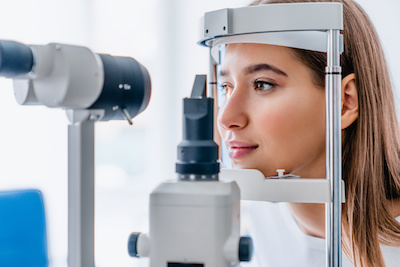Nutrition and Vision: Nutrients That Support Eye Health and Help Protect Your Vision

Your genetics, lifestyle, and diet all play an important role in the long-term health of your eyes and vision. Since your diet is almost wholly under your control, the following highlights important dietary choices you can make throughout life to support eye health. You’ll also read about the research behind those nutrition and vision recommendations, and several other steps you can take to optimize your vision.
Eating the Right Nutrients for Eye Health
Your diet, and the nutrients in it, impacts almost every aspect of your health. Your eye health can be supported by an overall healthy diet. However, there are several specific vitamins, minerals, and antioxidants that play a more important role in optimizing vision.
Vitamin C
Vitamin C can be found in virtually every cell in the body. It supports healthy capillaries, gums, teeth, and cartilage. But the essential vitamin’s concentration is significantly higher in the retina than in the blood. That’s because vitamin C helps maintain optimal performance by protecting your eyes from free radical damage.
Since the human body does not make vitamin C, it must be consumed as part of the diet. Some of the best sources of vitamin C are citrus fruits, peppers, broccoli, and kale.
Vitamin E
Like vitamin C, this essential nutrient is also an important antioxidant in the eye that helps neutralize free radicals. If left alone, over time free radicals can break down healthy tissue and impair long-term eye health.
Vitamin E deficiency is fairly common, since some of the best sources aren’t foods that people eat a lot of. To increase the vitamin E in your diet, try eating more sunflower seeds and oil, almonds, hazelnuts, peanuts, avocados, and spinach.
Zinc
This trace mineral is found in high concentrations in the eye. It plays a critical role in transporting vitamin A—another nutrient that supports eye health—to the retina. Zinc has been linked to preserving normal night vision. Dietary sources of zinc include oysters, red meat, shellfish, beans, and nuts.
Lutein & Zeaxanthin
These two powerful carotenoids both act as antioxidants. They serve as a built-in sunscreen for the eyes, where the nutrients help support blue light filtration. They also support healthy visual acuity (how clearly each eye can see).
Lutein and zeaxanthin are concentrated in your retina. The amount found there is directly proportional to your dietary intake of these carotenoids. To increase your consumption of lutein and zeaxanthin, try eating more dark green vegetables—like spinach, kale, swiss chard, broccoli, and parsley.
Omega-3 Fatty Acids
Fats are an essential part of the human diet. Most individuals eat enough of the essential omega-6 fatty acids; however low intakes of omega-3 fatty acids are common, particularly Docosahexaenoic acid (DHA) and Eicosapentaenoic acid (EPA).
Omega-3 fatty acids support the eye’s oily outer layer. DHA, in particular, is found in high concentrations in the retina. It is important in the visual development of new-born infants. Studies have also shown adequate levels of DHA can support optimal vision and help maintain retinal health.
Fatty fish, like salmon, herring, sardines, mackerel, and trout, are the best sources of EPA and DHA. Plant sources of EPA and DHA are harder to find, but the omega-3 fatty acid alpha-linolenic acid (ALA) is found in flaxseed, chia seeds, walnuts, and soybeans.
An Overview of the Research on Nutrition and Vision
Over the past three decades, there have been significant advances in research related to nutrition and eye health. Researchers now have a better understanding of how nutrition and vision are connected, and how nutrients support eye health, while helping maintain optimal vision as you age. The research studies highlighted below provide a basis for some of the previous nutrient recommendations.
Age-Related Eye Study
The Age-Related Eye Study (AREDS), was a major clinical trial that was sponsored by the National Eye Institute in the United States. The goal of the study was to take an in-depth look at the connections between dietary intake of several select nutrients and long-term eye health.
The study began recruitment in 1992, and involved 3640 subjects, ages 55-80. The subjects in the AREDS formula group were administered daily doses of:
- 500 mg vitamin C
- 400 IU vitamin E (180 mg dl-alpha-tocopheryl acetate)
- 15 mg beta-carotene (7,500 RAE)
- 80 mg zinc
- 2 mg copper (to avoid zinc-related copper deficiency)
Compared to placebo, supplementation with the AREDS formula had a measurable impact on supporting healthy eye aging, including support for visual acuity.
Age-Related Eye Study 2
AREDS2 data was first published in 2013 and tested several variations of the original AREDS formula. The primary goal was to test if adding lutein and zeaxanthin or omega-3 fatty acids would make the original AREDS formula more effective. One formula also tested a significantly reduced zinc level (25 mg vs 80 mg).
Study results show that adding lutein and zeaxanthin, or omega-3 fatty acids offered no additional eye health benefits over the original AREDS formula. However, using lutein and zeaxanthin in place of beta-carotene had a small benefit over the AREDS formula. The reduced zinc level was just as effective as the high zinc formula.
Based on the results of the AREDS2 study, it would make sense to use lutein and zeaxanthin in place of beta-carotene, limit zinc dosage to a safer level, and maintain the same levels of vitamin C, vitamin E, and copper.
An AREDS2-based formula might contain:
- 500 mg vitamin C
- 400 IU vitamin E
- 10 mg lutein
- 2 mg zeaxanthin
- 25 mg zinc
- 2 mg copper
Lutein Antioxidant Supplement Trial
Another landmark study was the Lutein Antioxidant Supplement Trial (LAST). It was a 12-month, placebo-controlled trial. The study tested both a purified lutein supplement, and a supplement with a mix of lutein and other antioxidants such as vitamin A, vitamin C, vitamin E, and beta carotene.
Both supplement groups had increased pigment density in the retina. Tests showed the supplements helped support visual acuity and glare recovery. The placebo group had no significant changes in these measured criteria.
Macular Pigment and Visual Performance Under Glare Conditions
A study on 40 healthy subjects assigned them to receive daily supplements of lutein (10 mg) and zeaxanthin (2 mg) for six months. The subjects’ eyes were tested for the effects of glare as experienced in everyday situations. This included being outdoors on bright days, lengthy sessions looking at a computer monitor, and nighttime exposure to oncoming headlights.
Following six months of supplementation, the participant’s average macular pigment optical density (MPOD) increased compared to the beginning of the study. Higher MPOD has been linked to optimal visual acuity.
After testing the subjects for their performance, researchers concluded that four to six months of supplementation with lutein and zeaxanthin supported healthy visual performance in high glare situations.
Nurses’ Health Study
The Nurses’ Health Study and the Health Professionals Follow-up Study involved more than 100,000 participants. All participants were aged 50 years or older and were free of targeted health concerns at baseline.
The researcher’s analyzed carotenoid intake based on dietary food frequency questionnaires at baseline and follow-up. Then they calculated predicted plasma carotenoid scores. The results of this study found that higher plasma lutein and zeaxanthin levels had a protective effect on the eye and helped support healthy eye aging.
Additional Tips to Protect Your Vision
Schedule an Eye Exam
When it comes to supporting your future eye health, it’s important to know where you stand now. An eye exam will measure visual acuity, but it can do so much more. With a comprehensive eye exam, it’s possible to detect future eye and vision problems long before they start showing more obvious symptoms.
Beyond an initial eye exam, it’s recommended that some individuals have follow-up exams more frequently too. The National Eye Institute recommends an eye exam every one to two years for:
- Everyone over age 60
- African Americans over age 40
- Specific medical conditions that may impact eye health
Wear Eye Protection
Just how you wear sunscreen to protect your skin from the sun, wearing sunglasses can help protect your eyes from harsh rays. Short-term, too much time in the sun can result in photokeratitis (sunburn of the eye). Enough UV exposure over time may lead to long-term eye damage.
Wearing sunglasses that block 99 to 100 percent of UVA and UVB radiation can help protect your eyes from short- and long-term damage from the sun. Contact lenses that are designed to block UV radiation are another solution. A brimmed hat will even provide additional protection for long days in the sun.
In addition to shielding your eyes against the sun’s UV radiation, it’s important to protect your eyes in dangerous situations. Appropriate eye protection should be worn during sports, construction, yard work, and any other time foreign objects may threaten your eyes.
Stay Active and Maintain a Healthy Weight
Staying physically active and maintain a healthy weight support optimal eye health. You can find some recommendations on how to maintain a healthy weight here.
If You Smoke, Quit Now
Smoking is dangerous for the whole body, including the eyes. Studies show smoking can harm the optic nerve and increase your risk for other eye health and vision problems.




